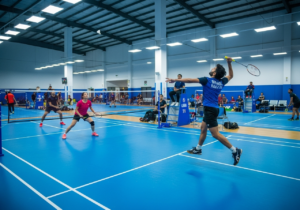Cricket Fitness: How to Build Endurance Like a Pro

Cricket fitness is no longer optional in today’s game. The rise of fast-paced formats like T20 and the intensity of Test matches demand elite levels of stamina, strength, and endurance. Whether you’re a casual player or chasing the pros, the right cricket workout plan can elevate your performance dramatically.
This guide is your complete playbook for cricket endurance training, including cricket fitness workouts, conditioning drills, nutrition, mental focus, and recovery strategies. Whether you’re an amateur cricketer, an aspiring player, or a fitness coach, this is how to increase fitness level for cricket and train like the pros.
Why Endurance is Essential in Cricket
Cricket is a game of patience, power, and persistence. A batter might spend hours on the crease. Bowlers deliver multiple high-intensity overs. Fielders can cover several kilometers in a single day. All of this demands physical endurance and mental resilience.
Endurance benefits for cricketers:

- Improved concentration during long innings or fielding spells
- Enhanced recovery between overs and during match breaks
- Consistent performance across multiple sessions and days
- Reduced injury risk due to better muscular and cardiovascular health
Understanding Cricket-Specific Endurance
Endurance in cricket combines both aerobic and anaerobic capabilities:
1. Aerobic Endurance
- This is your base-level stamina.
- It allows you to sustain low-to-moderate activity over long periods (e.g., long innings, fielding spells).
- Improves your heart and lung efficiency.
2. Anaerobic Endurance
- This supports high-intensity bursts—like sprinting for a run, bowling at full speed, or diving in the field.
- Helps you recover quickly between these efforts.
Endurance Training for Cricketers: The Pro-Level Routine
Let’s break down how professional players train their bodies for long-lasting performance.
Step 1: Aerobic Base Building
Why it matters:
It lays the foundation for overall endurance. Cricketers must remain energetic and alert over extended periods, and aerobic fitness plays a massive role.
Best aerobic workouts for cricket:
- Jogging (30–45 minutes)
- Cycling (outdoor or stationary)
- Swimming
- Rowing machine sessions
Training Tip: Start with 3 sessions/week. Gradually increase duration and pace over 4–6 weeks.
Step 2: Anaerobic Training (HIIT & Sprint Intervals)
Why it matters:
Most movements in cricket running between wickets, explosive deliveries, quick dives are short, intense efforts. Cricket fitness workouts should reflect that.
Sample HIIT Drills:
- Sprint 30–50m → rest 30s → repeat x 10–15
- Yoyo Intermittent Recovery Test (used in pro teams)
- Shuttle runs (10m, 20m, 40m)
Training Tip: Use cones to mark distances. Time your efforts to track improvements.
Step 3: Cricket-Specific Conditioning
This bridges the gap between fitness training and match performance.
Drills to try:
- Running between wickets: Practice explosive starts, sharp turns, and acceleration.
- Bowling endurance: Simulate 4–6 over spells in nets with 30–45s rest.
- Fielding circuits: Include dives, throws, and recovery runs.
Pro tip : Once you’ve mastered these drills, put them to use on the field by booking a ground via Khelomore – perfect for practice matches or solo sessions.
Step 4: Strength and Conditioning
Core exercises:
Endurance isn’t just about the lungs it’s also about muscular stamina. Cricket workout plans should include full-body strength routines, with an emphasis on the legs and core.
Core exercises:
- Planks (front, side)
- Russian twists
- Medicine ball throws
Lower body:
- Squats, lunges
- Box jumps
- Romanian deadlifts
Training Tip: Strength training 2x per week can significantly improve stamina and reduce
Step 5: Mental Endurance Training
Cricket demands mental strength, especially during long, tense match situations.
How to train your mind:
- Meditation (5–10 mins/day)
- Breathwork exercises for composure
- Visualization: Picture successful scenarios before and during matches
Nutrition for Cricket Endurance
Your cricket fitness workout is only as effective as your diet. Nutrition fuels performance and recovery.
Key Nutritional Guidelines:
- Carbs: Oats, brown rice, sweet potatoes for lasting energy
- Proteins: Eggs, chicken, lentils, Greek yogurt for recovery
- Healthy Fats: Nuts, seeds, olive oil for long-lasting fuel
- Hydration: Water + electrolytes (especially post-practice)
Sample Pre-Match Meal:
- Whole grain toast + banana + peanut butter + boiled eggs
Recovery: The Secret to Long-Term Endurance
Rest is where growth happens. Without it, even the best training plans backfire.
Essential Recovery Tips:
- Sleep: 7–9 hours for physical and mental repair
- Foam rolling: Releases tight muscles and improves blood flow
- Cold-water therapy: Reduces inflammation after tough sessions
- Active recovery: Walking, swimming, or yoga on rest days
Sample Weekly Cricket Fitness Plan (Endurance Focus)
| Day | Focus Area | Activity |
| Monday | Aerobic Conditioning | 45-min run + core circuit |
| Tuesday | Anaerobic Intervals | 10x50m sprints + 20m shuttle drills |
| Wednesday | Active Recovery | Swimming + stretching + meditation |
| Thursday | Cricket-Specific Drills | Bowling simulation + running between wickets |
| Friday | Strength & Core | Lower body circuit + plank variations |
| Saturday | Practice Match or Net Session | Game simulation + recovery routine |
| Sunday | Rest or Light Activity | Light jog or yoga + hydration + mobility drills |
Want to see your fitness in a real game setting ? Book your next session easily through Khelomore and put your training into action.
Final Thoughts: Endurance Defines the Modern Cricketer
Modern cricket demands more than just skill. The game now requires all-round athleticism, and cricket fitness is the backbone of peak performance. From T20 sprints to Test match marathons, endurance training is non-negotiable.
By combining aerobic and anaerobic work, cricket-specific workouts, strength training, nutrition, and recovery—you can increase your fitness level for cricket and dominate across all formats.




